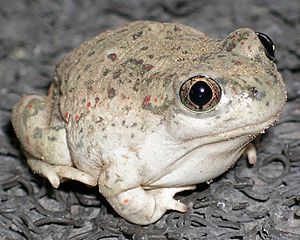New Mexico spadefoot toad facts for kids
Quick facts for kids New Mexico spadefoot toad |
|
|---|---|
 |
|
| Conservation status | |
| Scientific classification | |
| Genus: |
Spea
|
| Species: |
multiplicata
|
| Synonyms | |
|
Scaphiopus multiplicatus Cope, 1863 |
|
The New Mexico spadefoot toad (Spea multiplicata) is a type of American spadefoot toad. You can find it in the southwestern United States and Mexico. These toads get their name from a special spade-like bump on their back legs. This "spade" helps them dig easily into sandy soil. The New Mexico spadefoot toad has a unique wedge-shaped spade. Some people also call this toad the Mexican spadefoot toad, desert spadefoot toad, or southern spadefoot toad.
Contents
What Does the New Mexico Spadefoot Toad Look Like?
The New Mexico spadefoot toad is usually between 1.5 and 2.5 inches long. It has a round body and fairly short legs. Their skin can be green, grey, or brown. This color often matches the soil where they live. They might also have black and orange spots on their back. Their belly is white. These toads have large eyes with pupils that are shaped like a vertical line.
Behavior and Life Cycle
Like all spadefoot toads, the New Mexico spadefoot toad is a nocturnal animal. This means it is active mostly at night. They are also very secretive. If you pick one up, it might release a smell like peanuts. This smell can make your eyes water or nose run if you get too close.
Most of the time, these toads stay buried underground. They come out when it rains in the summer. During this time, they hunt for insects to eat. They also use the temporary pools of water left by the rain to breed.
Reproduction and Tadpole Development
Female toads lay their eggs in large groups in these rain puddles. The eggs hatch very quickly, sometimes in just 48 hours! The tadpoles must grow up fast before the water dries away.
New Mexico spadefoot tadpoles can change how they develop. If they find and eat small creatures called fairy shrimp, they can become "carnivore" tadpoles. This special change helps them grow even faster. Growing quickly helps the tadpoles turn into toads and leave the drying ponds sooner.
How Scientists Classify the New Mexico Spadefoot Toad
This toad was once thought to be a type of western spadefoot toad, Spea hammondii. But scientists looked closely at its body features. They found enough differences to make it its own separate species.
The New Mexico spadefoot toad can also hybridize with the Plains spadefoot toad (Spea bombifrons). This happens in places where both types of toads live. When they hybridize, it can sometimes be hard to tell the two species apart.
Fun Facts
- The New Mexico spadefoot toad is the official State Amphibian of New Mexico.
- The New Mexico Spadefoot Toad is one of the only species not officially threatened.
See also
 In Spanish: Sapo montícola de espuela para niños
In Spanish: Sapo montícola de espuela para niños


